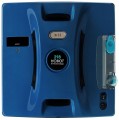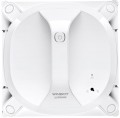Power supply
—
Network. Connection to a regular household outlet. The advantage of this option is its almost unlimited operating time. On the other hand, the power cord limits mobility and does not allow you to move away from sockets, and in their absence the device becomes useless. In addition, in some cases, the power cord can interfere with operation - for example, it will be clearly unnecessary for a heavy machine with a steering wheel and an operator's seat.
—
Battery. Battery-powered devices are extremely mobile: they do not depend on sockets and do not have a wire that limits movement. In addition, the absence of a wire has a positive effect on the overall convenience of work - it “doesn’t fit into your hand.” On the other hand, the continuous operation time of such a device is limited by the battery charge, and the machines themselves are heavier, bulkier and more expensive than similar mains-powered models. However, in some cases, the described advantages have a decisive advantage over the disadvantages: in particular, scrubber-drying robots (see “Type”), as well as heavy professional machines with steering control (see below), are powered by a battery.
— Network/battery. Devices that can operate both from the mains and from a built-in battery. The features of these types of nutrition are described in detail above; and their combination is used quite rarely. In particular, this method of power
...supply is provided in some window robots: the device uses a battery as standard, but if it is possible to run a wire, you can connect it to the network, saving battery power.Controls
The control method provided for in the design of the machine.
Note that for models with simple manual control (when the user holds the handle and thus directs the machine), as well as for robots controlled exclusively from their own built-in panel, this parameter is not indicated; it is given only for units with more advanced options. For traditional harvesting machines, this may be
the steering ; in turn, robots (see “Type”) can be controlled from
a remote control and/or
smartphone. Here's a more detailed description of these options:
- Steering. Control using a steering wheel or steering wheel. Used in heavy productive self-propelled equipment (see below), which would be difficult to deploy manually. Many of these models even have an operator seat and are essentially mini harvesting tractors of sorts. However, there are also units for which the operator must walk while working - they are somewhat less convenient to use, but are more compact, lightweight and inexpensive.
- Remote control. Control using a separate remote control supplied in the kit. More often, communication is carried out via an infrared channel - similar to remote controls for televisions, air conditioners, etc.; however, other options are possible. In general, the functionality of such control is quite limited compared to another option used in robots - control from a smartpho
...ne (see below): from the remote control, as a rule, only a selection of preset operating programs, simple settings, and in some models - also direct motion control. On the other hand, such control is relatively inexpensive, and for most cases it is more than enough.
- From a smartphone. Control the robot from a smartphone or other similar gadget (for example, a tablet) with a special application installed on it; Communication is usually carried out via Bluetooth. This method turns out to be much more convenient and visual than using a remote control: in particular, the application can implement many additional functions that are not available with a traditional remote control (cartography with manual routing on a map of the room, scheduled cleaning, etc.). On the other hand, supporting such control affects the overall cost of the unit; and in the absence of a suitable control gadget, the robot becomes completely useless. Therefore, this option is rarely found in its pure form - much more often the ability to work with a smartphone is provided simultaneously with the remote control (see below for more details).
— Remote control / from a smartphone. Devices that support both control methods described above. This option is as versatile as possible: when working with basic functions, you can get by with the remote control, and for advanced settings, use an external gadget. At the same time, the remote control is initially included in the delivery package, thanks to which the unit can be used without a smartphone - for example, if a suitable smartphone is not on the household, or if you do not want to bother with installing and configuring the application.Motor power
Rated power of the engine installed in the car.
Most often, this paragraph gives the total engine power. However, in units with a suction function - for example, scrubber dryers (see "Type") - only the power transmitted to the brushes can be indicated here. In such cases, the total power can be determined by summing the motor power and the suction power (see below). These details should be clarified separately. We also note that in self-propelled models (see above), part of the engine power is spent on moving the unit, which is why the useful power of such machines is lower than that of similar non-self-propelled equipment. In light of this, only models with the same movement format can be directly compared by this indicator - only self-propelled or only non-self-propelled.
Overall, higher motor power results in higher efficiency and productivity. However, there is no strict dependence here, and devices with similar engine characteristics can differ markedly in practical characteristics - productivity, working width, etc. So when choosing, it makes sense to pay attention first of all to these characteristics - especially since for some units (in particular, many robots) the engine power may not be supplied at all. As for specific power values, in the most modest equipment - in particular, household scrubber dryers - it
does not exceed 600 W ;
600 – 1200 W can be called average,
1200 – 1800 W is above average, and in powerful heavy units there are even
more respectable values.
Suction power
Working power of the machine for suction.
The effort with which the unit draws in pollution during operation directly depends on this indicator. The greater this effort, the higher the quality of cleaning and the more effective cleaning. On the other hand, even in the heaviest and most performant models, the suction power does not exceed 1200 W — it simply does not make sense to increase it further. In addition, we note that with an increase in the width of the grip, the suction power must also be increased, otherwise, the efficiency will decrease. It means that only models of the same type with the same or almost the same working width can be compared in terms of suction power.
Battery type
The type of battery used in the car with the appropriate power supply (see above). The type is indicated by the technology used to manufacture the battery.
- Ni-Cd. One of the oldest modern technologies. Such elements are capable of operating at high discharge currents, which is especially important for heavy and powerful equipment with high energy consumption. In addition, they charge fairly quickly, can withstand cold work and temperature changes without any problems, and are relatively inexpensive. One of the main disadvantages of nickel-cadmium batteries is the so-called. memory effect - a decrease in capacity if charging was carried out until completely discharged. However, this disadvantage can be compensated for by using high-quality chargers and following operating rules. But the clear disadvantage of this variety is environmental unsafety in production and disposal; It is precisely this that limits the use of Ni-Cd batteries in modern technology.
- Ni-Mh. A technology created in an attempt to improve the performance of the nickel-cadmium batteries described above. The attempt was quite successful: while maintaining the main advantages of their predecessors, nickel-metal hydride elements are at the same time less susceptible to the memory effect and more environmentally friendly. Their disadvantages include slightly increased cost and specific rules for long-term storage.
— Li-Ion. Lithium-ion batteries are notable primarily for their hig...h charge density - in other words, they have high capacity with small dimensions and weight. This is especially important for compact devices such as robots or manual window cleaners (see “Type”). In addition, such batteries are practically not subject to the “memory effect”. Among the disadvantages of this technology, in addition to cost, it is worth mentioning sensitivity to high and low temperatures, as well as the likelihood of “accidents” in abnormal conditions: failure of the built-in controller with overcharge or overdischarge, overheating or short circuit can lead to swelling, electrolyte leakage and even fire.
- Li-Po. A type of lithium-ion battery (see above), in which a polymer (gel) electrolyte is used instead of a liquid electrolyte. This design provides additional advantages over the original Li-Ion technology: lithium-polymer batteries have an even greater charge density, and the likelihood of “accidents” with explosions and fires in them is noticeably reduced. The main disadvantages of such power supplies are their rather high cost and the requirement to maintain optimal temperature conditions.
— Gel. In this case, we are usually talking about gel lead-acid batteries, similar to those used in cars. Such batteries are significant in weight, so they are used exclusively in heavy harvesting equipment, where several kilograms of battery weight are unnoticeable against the background of the weight of the machine itself. Among the practical advantages of such batteries, it is worth noting good capacity, durability, the ability to easily withstand deep discharge, as well as resistance to low temperatures and temperature changes.
Voltage
The voltage of the battery used in the machine with the corresponding type of power supply. This parameter is not key when choosing; it may only be needed when looking for a third-party charger or a replacement/spare battery, as well as for specific calculations related to capacity (see below).
Battery capacity
The capacity of the battery installed in the cleaning machine with the appropriate power supply.
In theory, a higher capacity allows you to work longer on a single charge, but in practice everything is not so simple. Firstly, the autonomy is also affected by the energy consumption of the machine, and it is determined mainly by the engine power (see above). Secondly, the actual amount of energy stored in the battery depends not only on the capacity in ampere hours, but also on the operating voltage in volts. Therefore, only batteries with the same voltage can be compared with each other in terms of capacity in Ah (or convert ampere-hours to watt-hours using a special formula and compare the results). And it is best to evaluate the autonomy of the unit by the directly stated operating time (see below).
Autonomy time
Operating time of a battery-powered cleaning machine on one charge of a standard battery.
This parameter itself is quite approximate: it is most often indicated for standard operating modes and simple conditions. However, the actual autonomy is usually not very different from the stated one; so, based on the stated operating time, it is quite possible to both evaluate the capabilities of different models and compare them with each other.
Charging time
The time required to fully charge the battery of cleaning machine (see "Power supply").
The larger the battery, the longer it may take to charge it. On the other hand, this moment also depends on the type of battery. In addition, special technologies are being used to speed up the process. So two machines with a similar battery capacity can differ in charging times.

